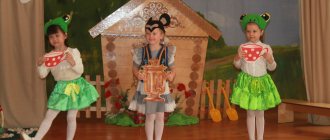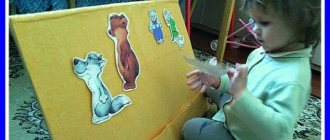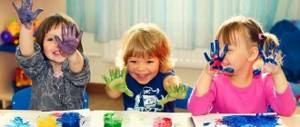MAGAZINE Preschooler.RF
Consultation for parents “Theater at Home”“It is necessary to teach a child from childhood to worry about other people’s misfortunes, to rejoice in the joys of others, to awaken in the receptive child’s soul this precious ability to empathize, rejoice, and compassion...”
K. I. Chukovsky.
Happy smiles, sparkling eyes and joyful faces of children after a puppet theater performance convincingly demonstrate how children love theater.
Such great joy can be brought to children not only by professional artists, but also by parents and older brothers and sisters.
Puppet theater creates a good mood, enriches children with impressions, evokes a variety of emotions in them, and contributes to their overall development and aesthetic education. Therefore, I want there to be more and more amateur puppet theaters, so that they enter the daily life of the family, so that their performances are interesting, bright and meaningful.
Theatrical art is close and understandable to children, because the basis of theater is play. An analysis of the role of theater in the formation of human artistic culture showed that, for example, schoolchildren who were interested in theater often had higher artistic taste than those who were far from the theater. Developed artistic taste is an important indicator of a person’s aesthetic upbringing.
What should theatrical games for preschoolers be like and how can we help children express themselves as fully and comprehensively as possible in their “children’s theater”?
Children's need for play is undoubtedly great and manifests itself very early. Already at 2-3 years old, the baby willingly imitates a jumping bunny or chicks running after their mother hen.
Very young children are grateful listeners and spectators if they know how to talk to them from the stage, taking into account their age characteristics. It’s good if moms and dads understand where and why they can take their baby?
But it’s better to show a small performance or game at home and even involve the baby himself in it.
Home performances have somehow lost their power now, since television and the computer have entered our home firmly and confidently, but they can never replace live creative communication between parents and children.
You should not be skeptical about the possibility of organizing theatrical performances for children at home. You can start with the simplest thing: having bought a new toy for a child, a mother can speak in the voice of a bear, a bunny, etc., and say that from now on this funny toy will live with you, but so that she doesn’t get bored, you need to talk to her every day. By communicating in this way, the child develops speech, imagination and creativity, which manifest themselves in play. This, of course, is not theater, but its elements are present here, an attempt to dramatize the action, perform improvised dialogue in roles, and identify certain character traits. And, of course, the “ultimate task” of parents is to force them to engage in dialogue and develop joint action with the character. That. without didactic pressure, you can teach a child simple game techniques, awaken their imagination and fantasy, and lead them to elementary creative manifestations.
Theater is important in children's lives. Children develop integrative qualities and the child’s personality develops. We noticed that during theatrical games even shy children relaxed.
In order to develop the theatrical activities of children, it is necessary to think about the equipment of the theater corner. The theater should be bright, attract the attention of children, make them want to act with the images of fairy-tale characters.
What different types of theaters can you make with your own hands? You can make theaters from scrap materials at hand, showing creativity and skill.
By doing theater with your children, you will make the life of your children interesting and meaningful, fill it with vivid impressions and the joy of creativity. And most importantly, children will be able to use the skills acquired in theatrical games in everyday life.
Let, from our good beginning, theatrical games and beloved fairy-tale characters accompany the child throughout his life!
Introduce a child into the world of theater, And he will learn how good a fairy tale is, He will be imbued with wisdom and kindness, And with a fairy-tale feeling he will follow the path of life!
| Next > |
Consultation for parents “Theatrical activities in kindergarten. Theater and parents."
Consultation for parents “Theatrical activities in kindergarten. Theater and parents."
The most important prerequisite for improving the speech activity of preschoolers is the creation of an emotionally favorable situation that promotes the desire to actively participate in verbal communication. The process of automating sounds is a painstaking and long work of a parent, teacher and speech therapist. Often the child simply refuses monotonous tasks and loses interest in such activities. The educational possibilities of theatrical activities are wide. By participating in it, children get acquainted with the world around them in all its diversity through images, colors, sounds, and the teacher’s skillfully posed questions force them to think, analyze, draw conclusions and generalizations. We can say that theatrical activity is a source of development of feelings and deep experiences and discoveries of the child, introduces him to spiritual values. But it is no less important that theatrical activities develop the emotional sphere of the child, make him sympathize with the characters and empathize with the events being played out. Thus, theatrical activities are the most important means of developing empathy in children, i.e. the ability to recognize a person’s emotional state by facial expressions, gestures, intonation, the ability to put oneself in his place in various situations, and find adequate ways to help.
Theater and parents.
The development of theatrical activities in preschool educational institutions and the accumulation of emotional and sensory experience in children is a long-term work that requires the participation of parents. It is important for parents to take part in theme nights in which parents and children are equal participants. Parents can play roles, take part in the production of scenery, costumes, etc. In any case, the joint work of teachers and parents contributes to the intellectual, emotional and aesthetic development of children.
The participation of parents in joint activities with their children evokes a lot of emotions in them, heightens the sense of pride for the parents who participate in theatrical performances.
Let's look at what kind of dolls there are and how to play with them.
Finger puppets.
Playing with fingers is the first step, getting to know the first gaming convention. This is the first theater that does not require a lot of time and money to produce attributes.
Take a sheet of paper 5-7cm wide, approximately the length of your index finger. If the puppeteer is a child, then the sheet of paper should be smaller accordingly. Roll the paper into a roll directly on your finger and glue it together. Next - paint, decorate with applique, beads or palettes. Be sure to make distinctive features of the characters: a crown for the king, a beard and mustache for the grandfather, and a handkerchief for the grandmother... It is interesting to play with such roll dolls, both alone and with a whole group. Put it on your finger... and you are no longer a mother, but a capricious princess! Such artists are also very suitable for fairy tales with a large number of characters. Each finger is a separate hero. So you can stage “Turnip”, “Teremok”, “Winter Hut of Animals”. This is where the performances are staged.
First, cut out the pictures you like from a magazine and glue them onto cardboard for strength. The figures should be no more than 10 cm in height.
Take half of the inner case of the chocolate egg. Make a slit on top of each with a knife. Insert a picture on cardboard into this slot. The hero of the new fairy tale is ready! This way you can create a whole family: mom, dad, baby, and provide them with the necessary household items. Make images of a crib, stroller, and table on the same stands. Any magazine illustration will be useful! Such actors and scenery stand firmly on the table and can be moved freely. And the fact that your fairy tale will not contain the traditional characters of grandma and grandpa is, perhaps, even better: you and your child can create a new fairy tale with new characters.
Cone dolls.
Take a sheet of thin cardboard or whatman paper and roll it into a cone (base diameter 7-10 cm). Glue or staple. Place it firmly on the table. This will be the torso of the future hero. Glue the head on top of the cone. Its image can be double: front view and rear view. We glue these two halves together, and inside, between them, is the top of the cone. Attach arms-legs and antennae-horns to the cone. Bulk dolls are more difficult to store. They wrinkle easily, so they need to be carefully placed in a box, and flat figures can be removed from the stands and even stored in an envelope. For a performance with such dolls, you can even make a decoration - a simple screen made of 3-4 thick sheets of large-format cardboard (A4 or A3), connected together with an accordion using tape or adhesive tape. It is elastic, durable, adheres well and does not rustle when opening and closing the screen. Tape transparent file folders in the form of pockets onto the sheets. There you will insert pictures that correspond to the theme of the action, and the screen will always be different. It’s better to take cardboard in different colors: it looks more interesting and can be used in a production. There are a couple of trees on a green background, so it turns out to be a forest. With blue it’s easy to imagine a sea or a river; with yellow or brownish you can create a road or a beach. It will be just like in a real puppet theater!
Glove puppets.
You can sew them yourself, or you can take an ordinary glove that has lost a pair. A ping pong ball with a hole for the index finger is suitable for the head. Using a permanent marker, draw a face on it, tie a scarf, or glue a head of wool threads with universal glue. If you are making a person's face, instead of a ball you can take a small ball covered with light fabric. If you want to get a fur face, you can not fit the ball, but simply choose it by color: brown for the bear, and white or gray for the bunny. The main thing here is accessories: a scarf for an old lady, braids for a girl, etc.
You can leave the glove itself as it is, or you can put a shirt or skirt on top. The baby will definitely love such dolls, they are like life: they move, they clearly have character, they talk and behave almost like people. Put such an “actor” on your hand, and you will feel that it is not you who is speaking. This doll makes you say words, dance and sing. Just listen!
Working on a toy with your child is very exciting. A toy made by a child, even with the help of an adult, is not only the result of his labor, but also a creative expression of the individuality of its creator. She is especially dear to him; with her it is much more fun to portray the heroes of fairy tales, songs, and short stories.
Parents! Do not waste time on home productions based on fairy tale materials - the result will be worth it.
This will be a real holiday for your children!
Consultation for parents “Theater in a child’s life” consultation (senior group)
Consultation for parents “Theater in a child’s life”
Goal: to introduce parents to theatrical art and theatrical activities.
Tasks:
• create conditions for organizing joint theatrical activities of children and adults, aimed at bringing children, parents: and teachers of preschool educational institutions closer together;
• contribute to improving the pedagogical culture of parents, replenishing their knowledge of the child’s theatrical activities in the family and kindergarten;
• implement an integrated approach to the mental and physical development of children through interaction with parents through theatrical activities.
Theatrical art is close and understandable to children, because the basis of theater is play. Theater has enormous power to influence a child’s emotional world. At first, parents take the main role in theatrical activities, telling and showing various fairy tales and nursery rhymes. But, already from the age of 3-4, children, imitating adults, independently play out fragments of literary works in free activity. Home theater is a collection of theatrical games and various types of theater.
Available for home use are puppet, tabletop and shadow theatres. Parents can organize a puppet theater using toys available in the house or making them with their own hands from various materials, for example, papier-mâché, wood, cardboard, fabric, thread, old socks, gloves. It is advisable to involve children in the work of making dolls and costumes. In the future, he will be happy to use them, acting out the plots of familiar fairy tales. For example, an old fur collar in dexterous hands can become a cunning fox or an insidious wolf. A paper bag can turn into a funny little man. Draw a face on the bag and cut a hole for the nose, insert your index finger into it, and the thumb and middle finger become your hands. Sock puppet: Stuff a sock with rags and insert a ruler inside. Secure everything together with string or an elastic band. Paper plate doll. Draw a face on a paper plate. Attach the stick to the back side with adhesive tape. Toys and dolls made from plastic bottles and boxes. The boxes can be glued together, covered with paper and parts can be glued. And so on... When creating a home puppet theater, you and your child will try on many roles: you will make puppets, draw scenery, write a script, design the stage, think over the musical accompaniment and, of course, show the performance itself. Just imagine how much creativity, ingenuity, and self-confidence this activity will require from the baby. And also training fine motor skills, developing speech, artistic taste and imagination, learning new and interesting things, the joy of joint activities with loved ones, pride in one’s successes... Indeed, creating a home puppet theater is such a developing and multifaceted activity that it is worth not regretting it time and effort. Children love to transform themselves into their favorite characters and act on their behalf in accordance with the plots of fairy tales, cartoons, and children's plays. Home performances help satisfy physical and emotional potential. Children learn to notice good and bad deeds, show curiosity, they become more relaxed and sociable, learn to clearly formulate their thoughts and express them publicly, feel and understand the world around them more subtly. The importance of theatrical activities cannot be overestimated. Theatrical games contribute to the comprehensive development of children: they develop speech, memory, determination, perseverance, and practice physical skills (imitation of the movements of various animals). In addition, theatrical activities require determination, hard work, and ingenuity. And how a child’s eyes light up when an adult reads aloud, intonation highlighting the character of each character in the work! Theatrical games always delight, often make children laugh, and are always loved by them. Children see the world around them through images, colors, and sounds. Kids laugh when the characters laugh, and feel sad and upset with them. With pleasure, transforming into their favorite image, kids voluntarily accept and appropriate its characteristic features. The variety of themes, means of representation, and the emotionality of theatrical games make it possible to use them for the purpose of comprehensive education of the individual. Parents can also become the initiators of organizing a variety of theatrical games at home. These can be fun games, dramatization games accompanied by singing such as “At the Bear in the Forest”, “Loaf”, “Turnip”, listening to fairy tales recorded on disks, followed by acting them out, and more. Such joint entertainment can play a big role in creating a friendly, trusting, creative atmosphere in the family, which is important for strengthening family relationships. To carry out this work, an appropriate artistic and aesthetic environment must be created in the family, which requires the presence of hand-made toys or dolls, a music library and library of fairy tales, children's musical instruments, homemade instruments, and educational games. But the most important thing is for adults to organize a variety of artistic and creative activities together with the child in various forms (dramatization, singing, dancing, round dances, games, etc.).
Dear parents! We invite you to play a series of theatrical games with your children that will help with the emotional and speech development of your child. Game “Tell with your hands” Ask the child to show who he saw on the street, in the zoo, etc. Exercises • Use facial expressions to express grief and joy; pain, fear, surprise. • Show how you sit in front of the TV (cartoon), while fishing (bites) Games with tongue twisters Tongue twisters must be practiced through very slow, exaggeratedly clear speech. Tongue twisters are first pronounced silently with active articulation of the lips; then in a whisper, then out loud and quickly (several times). Tongue twisters help children learn to quickly and clearly pronounce difficult-to-pronounce words and phrases. Variants of tongue twisters: Mother gave Romasha whey from the yogurt. The king is an eagle, the eagle is a king. Senya and Sanya have a catfish with a mustache in their nets. Broken telephone The first player hears a word from the leader, passes it along the chain, and the last participant says the word out loud. Finger games with words







